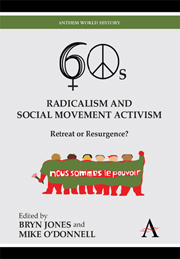Book contents
- Frontmatter
- Contents
- Introduction Sixties Radicalism: Creating Spaces and Leaving Legacies
- PART I Radical Movements Around the World
- PART II Theoretical & Cultural Significance
- 6 Nineteen Sixties Radicalism in the United States: Its Rise, Decline and Legacy
- 7 Students, Artists and the ICA: The Revolution Within
- 8 The Situationist Legacy: Revolution as Celebration
- 9 Habermas on Sixties Student Protests: Reflections on Collective Action and Communicative Potential
- PART III Social Movement Legacies
- Conclusion
- Notes on Contributors
- Author Index
- Subject Index
6 - Nineteen Sixties Radicalism in the United States: Its Rise, Decline and Legacy
from PART II - Theoretical & Cultural Significance
Published online by Cambridge University Press: 05 March 2012
- Frontmatter
- Contents
- Introduction Sixties Radicalism: Creating Spaces and Leaving Legacies
- PART I Radical Movements Around the World
- PART II Theoretical & Cultural Significance
- 6 Nineteen Sixties Radicalism in the United States: Its Rise, Decline and Legacy
- 7 Students, Artists and the ICA: The Revolution Within
- 8 The Situationist Legacy: Revolution as Celebration
- 9 Habermas on Sixties Student Protests: Reflections on Collective Action and Communicative Potential
- PART III Social Movement Legacies
- Conclusion
- Notes on Contributors
- Author Index
- Subject Index
Summary
Introduction
The purpose of this chapter is to explain the rise, character and trajectory of radicalism in the United States during ‘the long nineteen sixties’ and to comment on its significance to some of today's related issues. For comparative purposes, I will also refer to nineteen sixties radicalism in Britain. My already smouldering interest in American radicalism was ignited in 1968 when as a student I attended the ‘alternative’ democratic convention in Chicago, if ‘attended’ is the right word to describe the heavily policed gatherings of assorted radicals in the parks and streets outside the official Convention Hall. Since then I have made three research visits to the United States when I interviewed several activists and accessed a wide literature. More recently I interviewed ten British men and women (five of each) who were at a minimum sympathetic to the radical mood of the period (for a fuller description of my research base see O'Donnell 2008; and 2010 forthcoming). If 1968 was the height of sixties radicalism, its decline was also becoming apparent and I will treat 1968 as an approximate turning point.
Nineteen sixties radicalism in the United States was extremely diverse and was expressed in intermingling political and cultural ‘streams’. Accordingly, I will use the capitalised term ‘Movement’ to refer to the phenomenon as a whole. In so far as it is appropriate to separate the two streams, I use the term ‘New Left’ to refer to the various political groups of the Movement and the term ‘counterculture’ to refer to those who aspired to a radical and in some cases adopted an ‘alternative’ lifestyle.
- Type
- Chapter
- Information
- Sixties Radicalism and Social Movement ActivismRetreat or Resurgence?, pp. 91 - 110Publisher: Anthem PressPrint publication year: 2010



